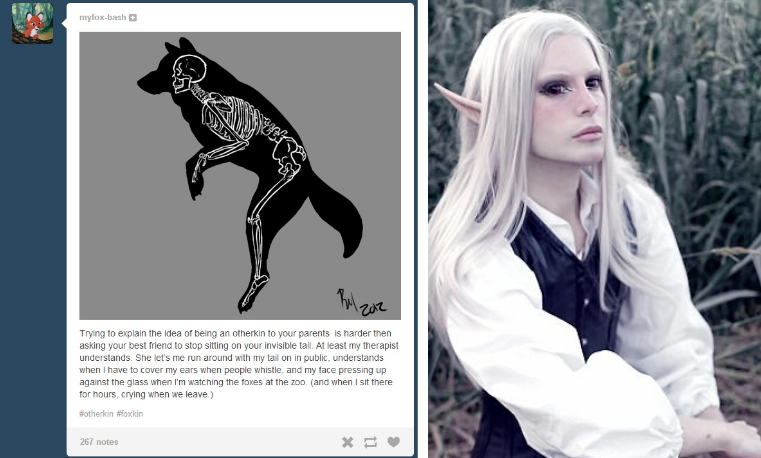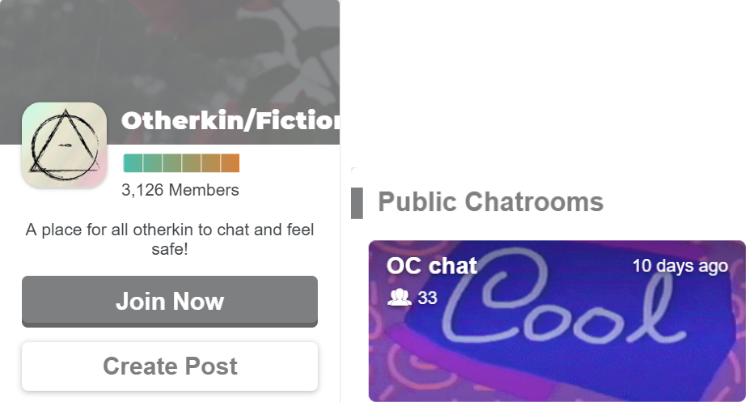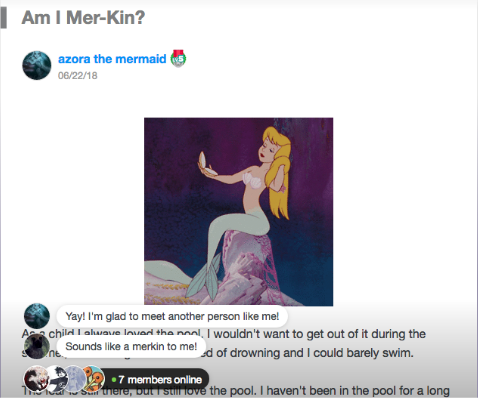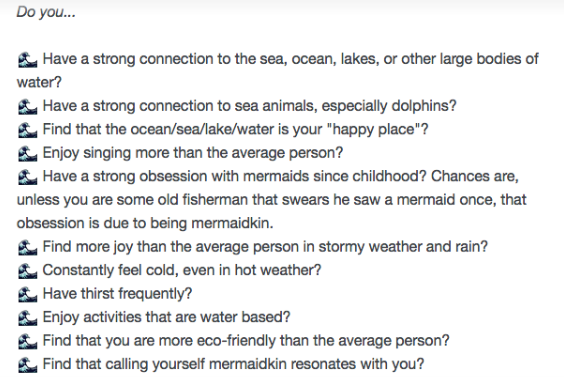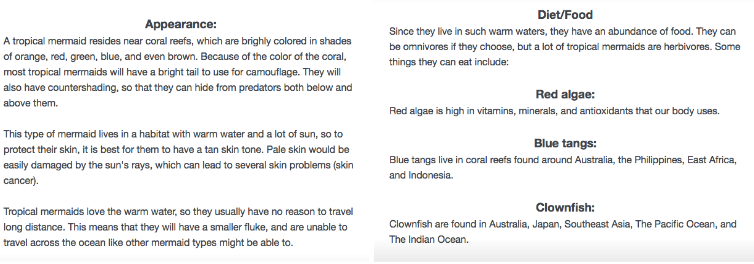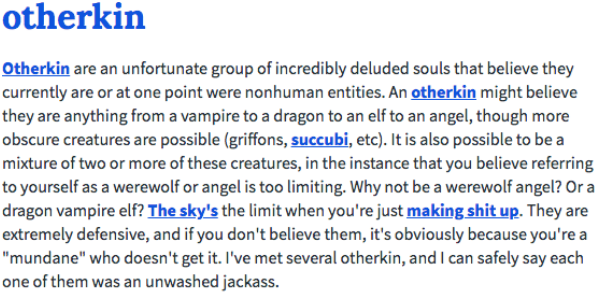
Dive into the Mermaidkin's online world
Mermaidkin are people who identify with Mermaids/Mermen, or believe are reincarnations of them (Kis, AminoApps, 2018).The Mermaidkin community exists and grows (mostly) online, and in this article I will analyse and describe this group with help from the social media platform AminoApps. This platform not only enables users to create and support online communities, but also serves as a Wiki where informational posts about the kintype Mermaidkin are shared. I chose Aminoapps because it is a place on the internet where many Merkins are actively communicating and spreading information about their kintype. The platform is a good indicator of the Mermaidkin community, and easily accessible.
My research shows that Mermaidkin is an online, translocal community of people who identify with - not as - Mermaids/Mermen. There are visions for physical and spiritual characteristics, but none of it is obligatory. Within Mermaidkin, there are multiple micro-populations that reveal a lot about the layered, scripted identity that a Merkin ‘performs.’ Merkins are seen as outsiders, but they believe that the rest of the world are the outsiders, or as the Merkins call them: the ‘mundanes.’
History of Mermaidkin
Mermaidkin, also called Oceankin, are people who identify with - not as - Mermaids/Mermen (Kis, AminoApps, 2018). Mermaidkin is part of a larger subculture called Otherkin, which is a subculture with people who socially and spiritually identify as not entirely human. This can be because of genetic reasons, ancestry, metaphor, or trans-species dysphoria of the soul (the feeling that your body or soul belongs to different species) (Wikipedia, 2018). For example, people can identify as a fox or an elf.
Figure 1. Otherkins can feel like a fox or an elf. The text below the image of the fox shows how difficult it can be to explain to others how you feel.
The Otherkin network, which includes Mermaidkin, is (mostly) an online phenomenon. There are occasional, rare, offline gatherings, but most Merkins only have online contact. The Mermaidkin communities on AminoApps refer to Otherkin as their origin, and to understand why Mermaidkin mostly exists online, we should take a look at the origin of Otherkin.
The most common and biggest belief within Otherkin is that of an Elven Holocaust, which is the story that humankind wiped all the elves from the earth (Urbandictionary, 2007). Despite the fact that there is no evidence (archaeological or otherwise) and no record for this holocaust or the existence of elves. Otherkin grew out of online elven communities of the early 1990s. These online (Elven) communities are the base for Otherkin as we know it today, and since Mermaidkin is a kintype of Otherkin, the Internet is also a base for Mermaidkin. For Mermaidkin, the Internet is an important infrastructure of their identity. It is because of the Internet that Mermaidkin (still) exists and grows.
Mermaidkin as a large and global community?
With the internet playing a big role for Mermaidkin, opportunities for a global reach are available. A popular platform on which members of the community come together is AminoApps. The Mermaidkin communities on AminoApps have between 3000 and 4000 members, there are always people online, and every chatroom has around thirty members. It is hard to say what percentage of the Mermaidkin community is active on AminoApps.
Figure 2. The Mermaidkin community is very active on AminoApps. Communities have between 3000 and 4000 members, and there are always Merkins online.
Merkins do leave some diverse guesses online about the scale and reach of Mermaidkin and Otherkin. Some say that Merkins tend to be non-religious people, others see Mermaidkin as their religion. Otherkin seems to be most active in cultures where people have a strong belief in reincarnation.Others say that most of the online Otherkin hail from the US or UK (Reddit, 2015). In other words: we can only estimate.
We do know that Mermaidkin is a translocal community that exists mostly online, and that this online community does have the opportunities of the internet to be global and large. Whether these opportunities are put into practice is something we do not have enough information about.
In his book ‘Nationalism and the Internet,’ Hylland talks about how the opportunities of the Internet have changed nationalism. Hylland says that the Internet can be used ‘to strengthen and confirm a particular cultural or religious identity’ (Hylland, 2007). For Merkins, the Internet helps with creating and maintaining Mermaidkin. As mentioned before, without the Internet - and thus AminoApps - many Merkins would not have been able to contact other Merkins, learn about Mermaidkin, and grow as a community.
Hylland also believes ‘that Internet resources help create a sense of social cohesion and cultural integration’. (Hylland, 2007). As for Mermaidkin, the community has found social cohesion and cultural integration online within their own community. Mermaidkin is very welcoming towards not only Merkins, but also different Otherkins.
When are you part of Mermaidkin?
The Mermaidkin communities on AminoApps talk a lot about what it means to be a Merkin and what kind of characteristics you should have. For example, ‘Azora the Mermaid’ shares her experience and asks others whether she is a Merkin or not. Azora says that she always misses the water when she is not in it, that she feels magical when her hair is floating around in the sea, and that she wishes to be able to breathe underwater (Azora the Mermaid, AminoApps, 2018). Other Merkin react and assure her that she is, indeed, a Merkin. (See image below).
Figure 3. A possible Merkin wonders whether s/he is a Merkin or not. Other Merkins react to her post on AminoApps, and tell her that she is a Merkin.
The way you feel is very important. There are lists on AminoApps that can help you determine whether you are a Merkin or not. These lists ask you if you ‘find yourself homesick or longing for the ocean frequently,’ or if you ‘have a calling to protect the world’s oceans and other bodies of water,’ and other examples. (Mal, AminoApps, 2018).
Figure 4. AminoApps shows lists of spiritual characteristics that you can use to indicate whether you are a Merkin or not.
Besides these spiritual characteristics, a Merkin has certain physical characteristics as well. Some of these physical characteristics are a bit more demanding, like having green eyes and red hair, or having very large lungs, and having gills behind their ears and inside their nose (Mal, AminoApps, 2018). But overall, the physical characteristics are more general.
The hair of a Merkin should be longer than ten centimeters, because the hair ‘serves a purpose of spacial detection, and balance while swimming’ (Kis, AminoApps, 2018). The hair is also practical for mermaids with babies, since babies cling to their mothers hair while she swims. For their hands, it is optional to have webs in between their fingers to improve swimming, or to have pointed or hardened fingernails for hunting.
And lastly, there are visions for how the ears of a Merkin look. I say vision, because the Merkins themself admit that the ears are the most complicated and hard to achieve. The ear shown in the picture below is an ideal, because that ‘ear is webbed out similarly to a fin on a tail’, and this improves aerodynamics in the water since they are mobile and able to move around. (Kis, AminoApps, 2018).
Interestingly, the communities on AminoApps do not say anything about the tail of the Mermaid in their Wiki’s, while other websites do share specific guidelines for how your tail can look. The website ‘Mermaidscorner’ shows the differences between the tails for each Merkin type. For example: the tropical mermaid should have a tail with coral colors to help with the camouflage (Mermaidscorner, n.d.).
Figure 5. Aminoapps serves as a Wiki, and shows the Merkins what their hands or ears can look like. Physical traits are less important than spiritual traits.
In their paper on micro-populations, Maly and Varis make a distinction between the local and global characteristics of a hipster: ‘Being a hipster, however, is a polycentric and layered affair, as the identity indexicals differ from one context to another, with some of them being more recognisable in a global scale (e.g. the big glasses), while others have more local purchase (specific to a particular country, city, etc.)’ (Maly & Varis, 2016).
For Mermaidkin, there is only a difference in characteristics based on what kind of Mermaid you are, but there is not a difference in global and local characteristics. The Wiki’s on AminoApps about the characteristics apply to everyone who enters the online community.
'One cannot be physically a Mermaid/Merman.'
Since the physical characteristics of Merkins are quite specific, the comment section on AminoApps is filled with Merkins wondering whether they actually belong to Mermaidkin or not. One of the answers comes from ‘Mal’, which says that ‘the physical traits are less important than the spiritual’ (Mal, AminoApps, 2018).
Another author, Kis, says under another post that the best way to know for sure whether you are a Merkin or not is to discover how you feel in specific climates, temperatures, or settings. The author Kis also adds: ‘In my opinion, no natural physical attributes of a human demonstrate one is a Mermaidkin; firstly due to the large amounts of variation in Mermaidkin and Human hair, skin and eye colour, but secondly because Mermaidkin believe to be spiritually or mentally Mermaids/Mermen. One cannot be physically a Mermaid/Merman’ (Kis, AminoApps, 2018).
This is where we see the difference between Otherkin types: some otherkin identify as the animal, and others identify with the animal in more of a spiritual way (Vice, 2015). Merkin might not identify with the physical traits of a Mermaid/Mermen, but (only) feel a special connection with Mermaids/Mermen and have the same spiritual traits.
Figure 6. On AminoApps, Merkins can ask each other questions about the traits of a Merkin. Here we see that the spiritual characteristics are more important than the physical characteristics.
This is interesting, and raises the question of enoughness in relation to identity. ‘Identity is a matter of ‘enoughness’: one has to have, display and enact ‘enough’ of the emblematic features in order to be ratified as an authentic member of an identity category’ (Maly & Varis, 2015). Those emblematic features can be incredibly small and only observable to those who are also part of that identity category, or they can be recognisable to anyone (Maly & Varis, 2016).
If the decision whether you are a Merkin or not is based on what your soul is telling you and how you feel, then it is a subjective decision that only you can make, which means that you do not need the approval or acceptance of others. Then, ‘enoughness’ and the characteristics you should own or feel in order to belong to Mermaidkin, are relatively easy to achieve. The physical characteristics are a vision that does not have to and/or can be achieved. The people who are already part of Mermaidkin basically leave the choice up to you: if you feel like a Merkin, then you are one.
Micro-populations and polycentricity within Mermaidkin?
Within Mermaidkin, there are certain "micro-populations." The different Merkin types that you can be are: arctic, deep sea, open ocean/traveler, freshwater, sirens, sirena chilota, merrows, aicaya, tropical, and cecealia. These Merkin types can be seen as micro-populations who each have their own communities on AminoApps. For example, the tropical mermaid is built for tropical temperatures and short distance swimming. (For more information, see image below).
Figure 7. AminoApps provides a lot of information about each Merkintype. For example, the tropical mermaids are herbivores.
Each Merkin type has specific behavior traits that can be seen in the human behind the Merkin as well. For the tropical mermaid this includes being more relaxed and carefree (Pink Btch, AminoApps, 2018). A human that identifies with an open ocean mermaid is very determined and loyal (Pink Btch, AminoApps, 2018). Some characteristics apply to both mermaids, for example: being shy towards humans.
The identity of a Merkin is interesting, and it raises questions like: can you be multiple Mermaids/Mermen at the same time? As we saw previously, you can have characteristics that belong to multiple micro-populations, and thus you could have multiple identities at the same time. The intention, however, is that you are only one type of Merkin.
'A Merkin can choose whether s/he feels like a human or a Merkin and in which situations s/he wants to be a human or a Merkin.'
Another interesting aspect is that the characteristics of your chosen Merkin can say something about you as a human being, which could mean that you are always part Merkin and part human at the same time. Since (most) Merkin identify with the Mermaid/Mermen, instead of as the Mermaid/Mermen, it is possible that a Merkin has the spiritual parts of a Merkin and the physical parts of a human.
In this case, there are layers to the Merkin identity, and they can switch between being a Merkin and being a human. You could also say that the identity is scripted, and that a Merkin can choose whether s/he feels like a human or a Merkin and in which situations s/he wants to be a human or a Merkin.
danah boyd talks about ‘impression management’: ‘what we convey to others is a matter of what we choose to share in order to make a good impression and also what we unintentionally reveal as a byproduct of who we are and how we react to others’ (boyd, 2015). When on AminoApps, the Merkin releases his/her inner Merkin, and in situations where it is more appropriate to be a human, they are a human.
As boyd says: ‘Based on their understanding of the social situation - including the context and the audience - people make decisions about what to share in order to act appropriately for the situation and to be perceived in the best light’. (boyd, 2015). A distinction between offline and online life is not possible because Merkins also feel like Merkins in the offline world, but Merkins will probably use the human part of their identity more offline, and the Merkin part more online. Merkins have the choice between multiple identities, and in every situation they can choose what identity they would like to ‘perform.’
The power structure within Mermaidkin
‘With regard to their online communities, otherkin largely function without formal authority structures, and mostly focus on support and information gathering, often dividing into more specific groups based on kintype’ (Wikipedia, 2018). This quote applies perfectly to AminoApps, where the communities are all about supporting each other and providing information: many questions are being asked and everyone helps each other with finding out whether you are a Merkin or not. The Wikis hold a lot of information about physical and spiritual characteristics, and in the comment section there is room for Merkins to meet each other and share experiences.
Mermaidkin uses AminoApps to create and maintain a feeling of home and to be one big family. This means that there is not one powerful person or group that creates the norms or rules, but anyone can participate. For example, anyone can create blogposts and challenges (AmyOttercat, AminoApps, 2016; KavyKakata, AminoApps, 2018).
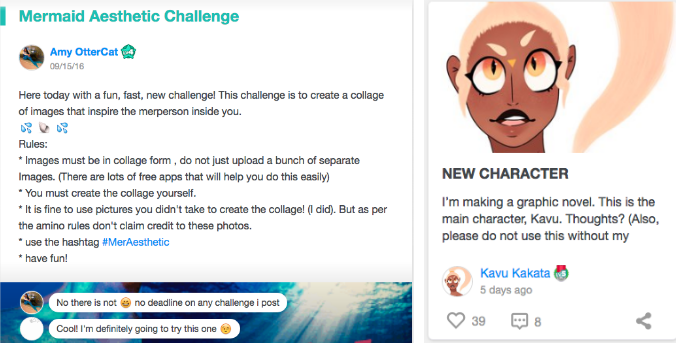
Figure 8. The Merkins on AminoApps come up with challenges for the community, and they share their art with each other.
There are definitely Merkins who are more active and have more followers, and thus are seen as more influential, but the community is accessible for everyone and even these more ‘popular’ Merkins love to join challenges from others and they talk to everyone. There is also not any competition between the different micro-populations of Merkins: everyone gets accepted the way s/he is, and Merkins love to update each other about their activities. For example, the books they are reading, or the outfits that they are making (AbigailScheppert, 2018).
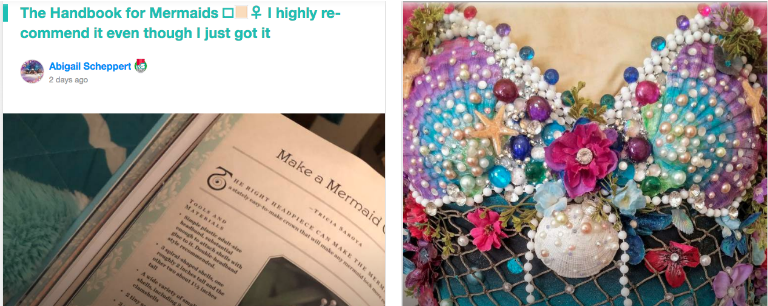
Figure 9. On AminoApps, Merkins recommend each other books, and show their Merkin outfits.
Outsiders or mainstream?
Mermaidkin are seen by most people, except for the community itself and the larger group Otherkin, as outsiders. As Becker says: ‘All social groups make rules and attempt (...) to enforce them’ (Becker, 1963). The rules that Mermaidkin has, the way they behave and feel, does not align with the mainstream rules of society. Mermaidkin thus breaks the rules, and ‘when a rule is enforced, the person who is supposed to have broken it (...) is regarded as an outsider' (Becker, 1963). Besides outsiders, Mermaidkin is also seen as a religion or online belief and nothing more than that. Some people even go as far as to say that Merkins are psychologically dysfunctional (Wikipedia, 2018).
'Some people even go as far as to say that Merkins are psychologically dysfunctional.'
There are discussions online about whether Mermaids/Mermen are a myth, or whether we have evidence that they exist. Most people have accepted Mermaidkin, but only as a myth. Overall, Mermaidkin does not get taken very seriously by society (Procaffenation, 2018). There is also quite some hate and aggression online towards Mermaidkin, and Otherkin is called one of the world’s most bizarre subcultures (Wikipedia, 2018). An example of mild hatred is shown below.
Figure 10. Mermaidkin are seen as outsiders, which results in hate online.
Within the Mermaidkin community on AminoApps, there are no outsiders: everyone is welcome to join and become a Merkin. Becker talks about how the person who is labelled as an outsider may look at things differently: the rulebreaker, and thus ‘outsider’, may feel like the people who judge him are actually the outsiders.
Just as the jazz musicians call their audience, who do not have a proper understanding of what it means to be a musician, the squares (Becker, 1963), Otherkin uses the name ‘Mundane’ for everyone who does not believe in the subculture, is not a part of it, or does not know about Otherkin. Otherkins believe that they have a sense of superiority over their fellow human beings, and Mundanes are looked down upon: Mundane means common, ordinary, or unimaginative(AnotherWiki, 2018).
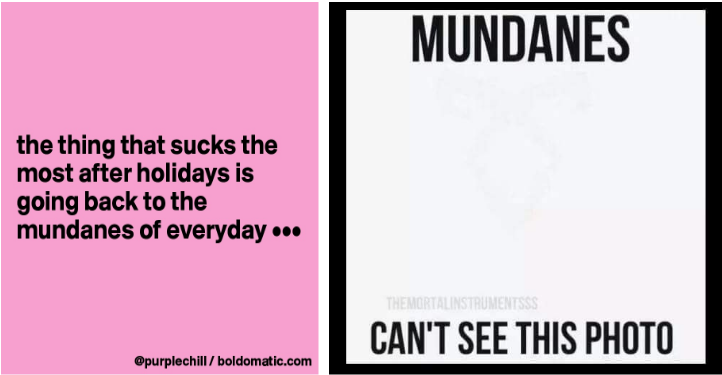
Figure 11. Whilst Mermaidkin is seen as an outsider, Merkins think it is the other way around and call everyone else 'Mundanes'.
The online Mermaidkin community
Mermaidkin, part of the subculture Otherkin, are people who identify with - not as - Mermaids/Mermen. It is a translocal community that exists mostly online, and uses the Internet, such as the platform AminoApps, to extend and maintain their community. There are physical as well as spiritual characteristics, with a emphasis on the spiritual. Whether you are a Merkin or not and whether you have enough characteristics depends on how you feel and is thus a subjective choice that you make, instead of the Merkins who are already part of the community. As an author on AminoApps says: ‘One cannot be physically a Mermaid/Merman’ (Kis, AminoApps, 2018).
Within Mermaidkin, there are multiple micro-populations who each have their own communities on AminoApps. Each micro-population has characteristics which can be different as well as the same as the characteristics of another micro-population, and the characteristics also reveal something about the human behind the Merkin. This results in layered, scripted, ‘performed’ identities. Mermaidkin functions without formal authority structure, and the communities on AminoApps are about gathering information and supporting each other. Merkins are seen as outsiders, many people do not take Mermaidkin seriously and see it as a myth or online religious movement, but within Mermaidkin everyone gets accepted. The paradox here is that Merkins do not see themselves as outsiders, and everyone who is not a Merkin gets called a Mundane. So the choice is up to you: are you a Merkin or a Mundane?
References.
AbigailScheppert. (2018). Hi my name is Auquita. AminoApps.
AbigailScheppert. (2018). The Handbook for Mermaids. AminoApps.
Amber Roberts. (2015). We talked to the Growing Online Community of ‘Otherkin’: People Who Identify as Non-Human. Vice.
AmyOttercat. (2016). Mermaid Aesthetic Challenge. AminoApps.
Anamika Tiwari. (2018). Mermaids and Mermen: a myth or do they really exist? Procaffenation.
AnotherWiki. (2018). Mundanes.
Azora the Mermaid. (2018). Am I Mer-Kin? AminoApps.
boyd, d. (2015). Impression management in a networked setting.
Howard Becker. (1963). Outsiders, studies in the sociology of deviance. The free press.
Hylland, E. (2007). Nationalism and the internet, nations and nationalism. University of Oslo, Norway, and Free University of Amsterdam.
KavuKakata. (2018). New Character. AminoApps.
Kis. (2018). Mermaidkin: An Otherkin. AminoApps.
Mal. (2018). Are you mermaidkin? AminoApps.
Maly, I & Varis, P. (2016). The 21st century hipster: on micro-populations in times of super-diversity. European Journal of Cultural Studies.
Mermaidscorner. (n.d.). Sub-species of Mermaids, Tail examples, and Anatomy.
Pink Btch. (2018). Open Ocean Mermaids. AminoApps.
Pink Btch. (2018). Tropical Mermaids. AminoApps.
Stoneysiren. (2015). Researching and questioning. I want to do ethnographic work on Otherkin and Vampires. Also, kinda questioning for myself. Are there Merfolk/Mermaidkin? Reddit.
Urban Dictionary. (2007). Otherkin.
Wikipedia. (2018). Otherkin.
